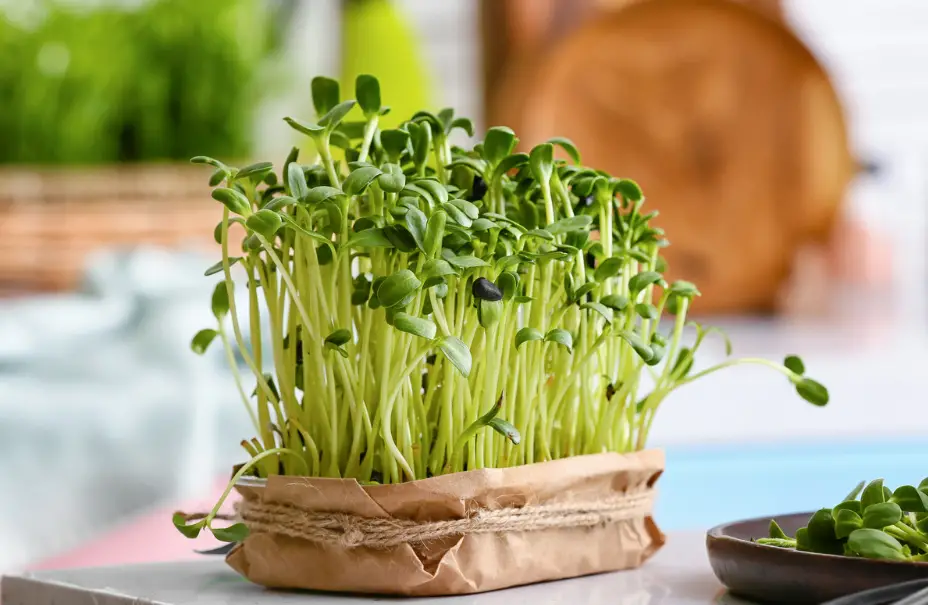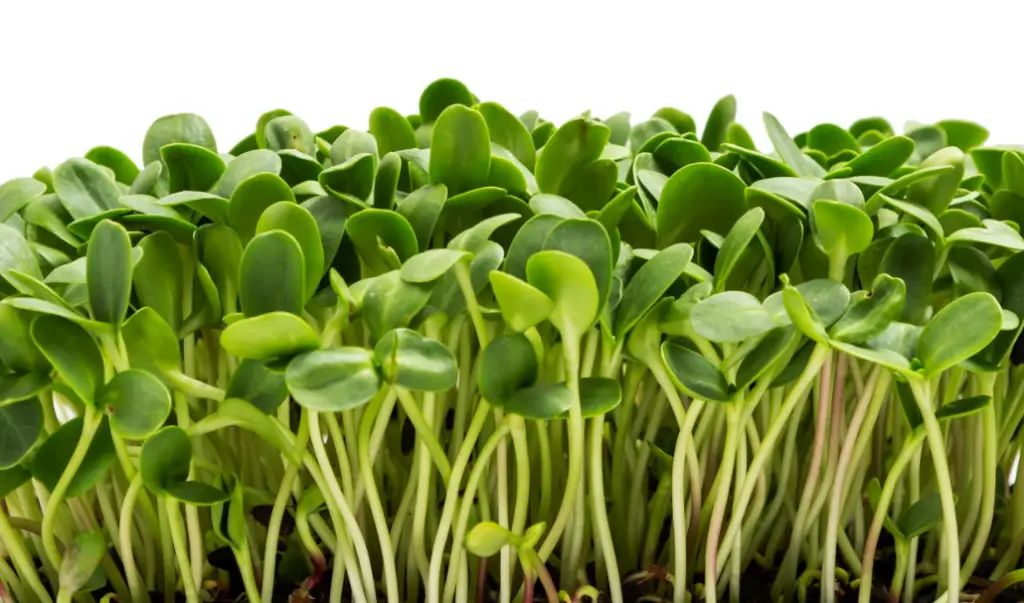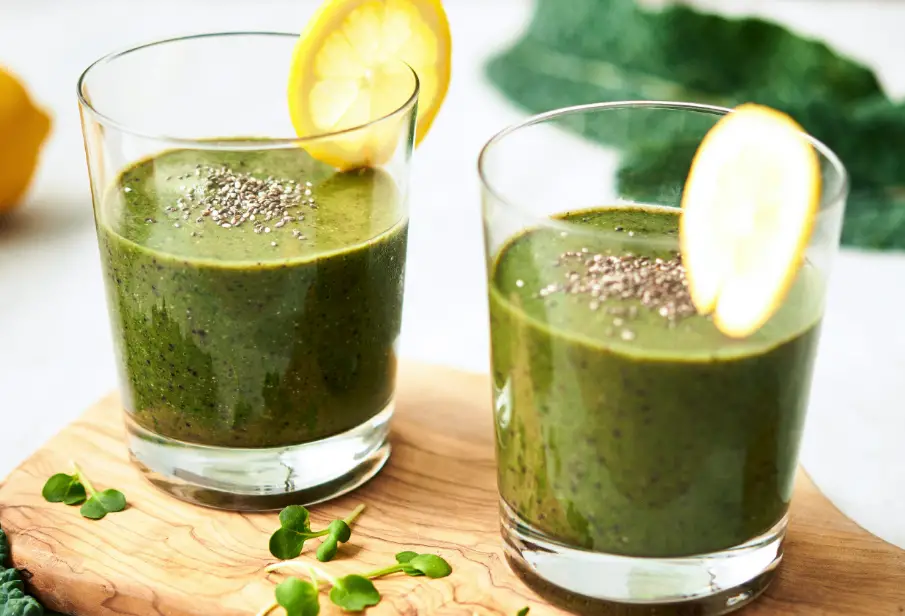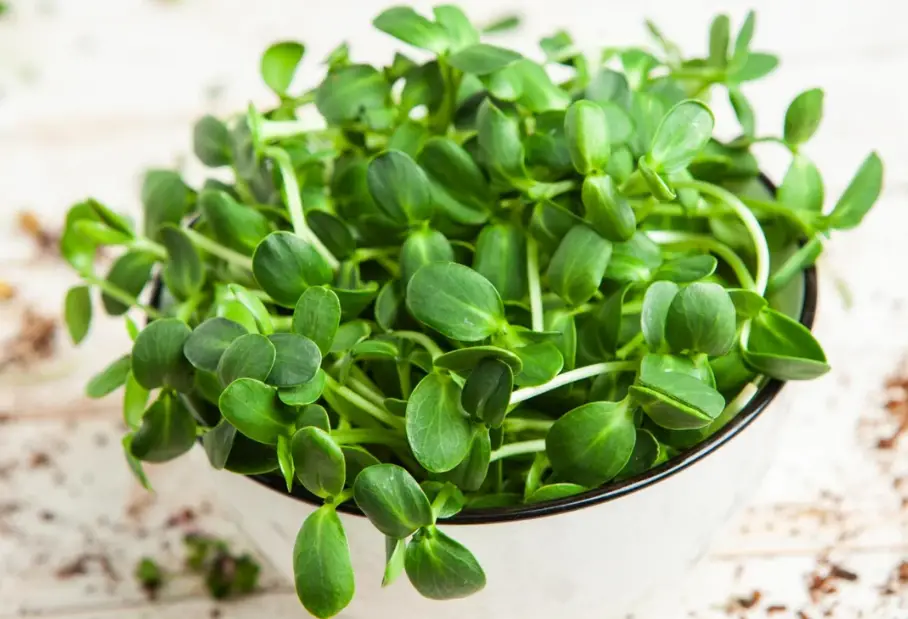Sunflower microgreens have gained popularity among health enthusiasts and home gardeners in recent years.
These small, tender, and nutrient-packed greens are a rich source of vitamin E, C, B, and minerals, and antioxidants. Unlike mature sunflowers, which produce seeds that are high in fat and calories, sunflower microgreens are low in calories, yet high in nutrients.
In this article, we will explore the nutritional benefits of sunflower microgreens and how they can be an excellent addition to your diet. We will delve into the vitamins, minerals, and other essential nutrients present in sunflower greens and their potential health benefits.

Contents
- 1 Definition of microgreens
- 2 The nutritional content of sunflower microgreens
- 3 Health benefits
- 4 How to incorporate sunflower microgreens into your diet?
- 5 Growing sunflower microgreens at home
- 6 Tips for growing and harvesting sunflower microgreens
- 7 Future research and possibilities for sunflower microgreens
- 8 FAQ
- 9 Conclusion: final thoughts on incorporating sunflower microgreens into a healthy diet
Definition of microgreens
Microgreens are a type of edible greens, harvested just after the cotyledon leaves have developed. These tiny plants are packed with minerals, and they have become increasingly popular in recent years due to their nutritional value and versatility.
Microgreens have been around for decades, but it wasn’t until the 1990s that they gained popularity in the United States.
Importance of microgreens in the diet
Incorporating microgreens into your diet is an excellent way to boost your intake of essential vitamins and minerals and to improve your immune system. They contain high levels of antioxidants and other beneficial plant compounds that can help reduce inflammation and support overall health.
Microgreens are also rich in fiber and are easy to digest, making them a great addition to a nutritional diet.
Benefits of growing and consuming microgreens
Growing and consuming microgreens offers a variety of benefits. They are easy to grow and can be grown in a small space, making them a great option for those with limited space or without access to outdoor gardening.
Additionally, they can be grown year-round, ensuring a steady supply of fresh greens.
Consuming microgreens can also help reduce food waste by providing a way to use up small amounts of seeds and soil.
A brief overview of sunflower greens
Sunflower seeds are the edible seeds of the sunflower plant. They are flat, oval-shaped, and typically have a black and white striped outer shell. Black oil sunflower seeds are a source of nutrients, including protein, healthy fats, vitamins, fiber, and minerals.
Sunflower seeds can be eaten raw or roasted and are commonly used in a variety of recipes, including as a snack, in salads, and as an ingredient in baked goods.
Sunflowers, in particular, are a popular variety of microgreens, mostly grown from black oil sunflower seeds. They are easy to grow and offer a unique flavor and texture compared to other microgreens.
They are also highly nutritious, containing vitamins such as vitamin C, E, and folate, and minerals such as iron and potassium. They are an excellent addition to salads, sandwiches, and smoothies, and can also be used to add flavor and texture to cooked dishes.

The nutritional content of sunflower microgreens
Sunflower microgreens are an excellent source of nutrients that are essential for human health. They are a source of vitamins A, C, E, and K, as well as B vitamins such as folate and niacin. They also contain essential minerals for an immune system such as calcium, iron, magnesium, and potassium, as well as trace elements such as zinc, copper, and manganese.
Vitamins and minerals
In terms of nutrient content, they are a nutritional powerhouse. For instance, a study showed that these microgreens contain 25 times more iron and almost 6 times more vitamin E than mature sunflower plants. Additionally, they contain a significant amount of essential amino acids, the building blocks of protein.
Nutrient comparison between mature sunflower plants vs microgreens
When comparing the sunflower microgreens’ nutrition to mature sunflower plants, microgreens have been found to contain higher concentrations of some essential nutrients.
Although mature sunflower plants are also nutrient-rich, they don’t possess the same level of concentration as microgreens. This is because microgreens are harvested at an early stage, where they have the highest nutrient concentration per weight.
So, consuming sunflower microgreens is a more effective way of obtaining a high concentration of nutrients from sunflowers.
Nutrient comparison between sunflower and other popular microgreens
Compared to other popular microgreens such as broccoli and radish, sunflower microgreens have a comparable or even higher nutrient content.
For example, in one study, sunflower microgreens had higher concentrations of vitamin C and beta-carotene than broccoli microgreens.
Another study found that they had a higher content of some minerals such as zinc and magnesium compared to radish microgreens.

Health benefits
Sunflower microgreens are not only delicious but also offer various health benefits. These benefits are due to the presence of essential vitamins that contribute to a healthy diet improving the immune system.
Anti-inflammatory properties
One of the key benefits of eating sunflower microgreens is their anti-inflammatory properties. They are known to reduce inflammation in the body and prevent chronic diseases caused by them.
Consumption of sunflower microgreens’ nutrition can help reduce inflammation in the body, thereby preventing the onset of chronic diseases.
Additionally, they contain a significant amount of chlorophyll, which also has anti-inflammatory properties. Chlorophyll has been found to inhibit the growth of harmful bacteria and to stimulate the production of healthy cells in the body, further promoting overall health.
Antioxidant properties
They are also a rich source of antioxidants, which help to prevent cell damage caused by free radicals. The antioxidants found in these microgreens are effective in neutralizing free radicals, which are unstable molecules that can cause cell damage, aging, and disease.
Cardiovascular benefits
In addition to their anti-inflammatory and antioxidant properties, sunflower microgreens have cardiovascular benefits.
They help to lower cholesterol levels and promote heart health by reducing the risk of developing heart diseases. The dietary fiber present in these microgreens also helps to reduce the risk of heart disease.
Digestive benefits
The digestive system can also benefit from these microgreens.
They are rich in dietary fiber, which helps to improve digestion and promote bowel regularity.
They are complete foods which makes them a good addition to the diet for people who suffer from digestive problems because eating sunflower microgreens easily breaks fatty acids.
Other potential health benefits
They may also have other potential health benefits, including immune system support, cancer prevention, and improved skin health.
Sunflower shoots are believed to have potential health benefits for blood supply. They are rich in chlorophyll, a nutrient that has been linked to improved blood quality and increased oxygen supply to the body’s tissues.
Additionally, sunflower shoots are a source of minerals and vitamins such as vitamin C, B vitamins, and iron, which are important for the production of healthy red blood cells.

How to incorporate sunflower microgreens into your diet?
Incorporating sunflower microgreens’ nutrition into your diet can be an easy way to boost your nutrient intake.
There are a variety of ways to eat sunflower microgreens in meals, making them a versatile addition to any diet.
Ideas for using sunflower microgreens in meals
They are versatile ingredients that can be used in a variety of dishes to add flavor, texture, and nutrition.
Here are some ideas to eat sunflower microgreens:
Toppings
Sunflower shoots can be used as a topping on a variety of dishes, including soups, salads, sandwiches, and wraps.
Their delicate texture and mild flavor make them a perfect complement to many different flavors.
Omelets and Frittatas
Sunflower microgreens can be added to omelets or frittatas for a burst of color and flavor.
They pair well with eggs and cheese and add a nutrient boost to your morning meal.

Smoothie Bowls
Sunflower microgreens can be used as a healthy and colorful topping for smoothie bowls. They add a fresh flavor and a crunchy texture that pairs well with smoothie ingredients like bananas, berries, and yogurt.
Stir-fries
Sunflower microgreens can be added to stir-fries for a fresh and nutritious touch. They can be added at the end of cooking, and pair well with a variety of vegetables, proteins, and sauces.
Sunflower microgreens as a salad ingredient
One popular way to use sunflower microgreens is as an ingredient in salads. They add a fresh, crunchy texture to any salad, and can be used in place of or in addition to other salad greens.
Sunflower microgreens are also great for adding a pop of color to salads, as they have a bright green appearance.
Sunflower microgreens in juices
Another way to incorporate sunflower microgreens into your diet is by using them in smoothies and juices.
They can be blended with fruits and vegetables to create a nutrient-packed beverage. Sunflower microgreens have a mild, nutty flavor that blends well with a variety of flavors.
Other creative ways to use sunflower microgreens
There are also many other creative ways to use sunflower microgreens in meals. They can be used as a topping for sandwiches or wraps, or as a garnish for soups and stews.
Sunflower microgreens can also be used as a filling for sushi or pasta dishes. The possibilities are endless!

Growing sunflower microgreens at home
Growing sunflower seeds at home have become increasingly popular due to their ease of cultivation and numerous health benefits.
By following these simple steps, you can grow your own delicious and nutritious sunflower microgreens at home.
Materials and tools needed for growing sunflower microgreens
To grow microgreens, it is important to have the necessary materials and tools.
Firstly, growing trays are required which come in different sizes and shapes. One can choose from a variety of materials like plastic, terracotta, or wooden trays.
Potting soil is also essential for growing microgreens, and a spray bottle is another important tool to mist the microgreens and keep the soil moist.
And the most important: do not forget the sunflower seeds!
How to grow microgreens?
When growing microgreens, the first step is to soak the sunflower seedlings for a few hours before placing them on the prepared growing medium.
The sunflower seeds should be spread out evenly on the growing medium, and the trays should be placed in a location that receives plenty of light.
Step-by-step instructions for growing sunflower microgreens
To grow sunflower greens, first, soak the seeds in water for 8-12 hours.
Next, take a growing container and add 2 inches of moist growing medium to it. After that, spread the soaked sunflower seeds evenly on top of the growing medium and lightly spray them with water. Then, cover the container with a lid or plastic wrap to create a greenhouse effect and place it in a warm, bright location, or under a grow light.
After 3-4 days, the seeds will start to sprout and you need to remove the cover and continue to mist the sprouts daily.
Once the sprouts are around 2 inches tall, move the container to a location with bright, indirect light. Continue to water and mist the sprouts daily. When the sunflower microgreens reach a height of 7-10 days, they will be ready to harvest.
To harvest, use scissors to cut the microgreens just above the soil level, rinse the harvested microgreens with water, and pat them dry. Finally, store the microgreens in an airtight container in the refrigerator for up to a week.
Sunflower vs other microgreens in terms of growing difficulty
Compared to other microgreens, sunflower microgreens are relatively easy to grow.
They, do not require any special equipment or conditions, making them an ideal choice for beginner gardeners. They also have a fast growth rate and can be harvested in as little as 7-14 days.
Tips for growing and harvesting sunflower microgreens
To ensure a successful harvest, there are several tips that one can follow.
These include keeping the soil moist but not waterlogged, providing adequate ventilation, and ensuring the growing medium has good drainage.
Additionally, one should avoid overcrowding the trays and use high-quality seeds from reputable sources.
Mistakes to avoid
Some common mistakes should be avoided when growing these microgreens.
These include not providing enough light, overwatering, and using soil that is too compact. By taking the time to learn proper growing techniques and avoiding these common pitfalls, one can enjoy a bountiful harvest of nutritious sunflower microgreens.

Future research and possibilities for sunflower microgreens
Agricultural and food chemistry involves the study of the chemical composition, properties, and behavior of agricultural products and food, and how they interact with their environment.
In the case of sunflowers, agricultural and food chemistry research may focus on the chemical components of sunflower seeds, such as oils, proteins, and antioxidants. This research may investigate the nutritional properties of sunflowers, and how they can be used in food products to improve their nutritional profile.
Here are some effects of sunflower microgreens’ nutrition and value that are being researched:
- Healthy fat loss program
One possible avenue for research is to explore the effect of sunflower microgreens on weight loss.
Sunflower microgreens are a low-calorie, high-nutrient food, with healthy fats, which makes them an excellent candidate for weight loss diets. Future studies could examine the effect of sunflower microgreens on appetite, metabolism, and overall weight loss.
- Mental health benefits
Another area of potential research is the effect of sunflower microgreens on mental health. Research has shown that a diet rich in sunflower microgreens’ nutrition and antioxidants can have a positive effect on mental health.
Sunflower microgreens are an excellent source of minerals and vitamins, including vitamin E and folate, which are known to support mental health.
Future studies could explore the potential of sunflower microgreens’ nutrition to improve mood and alleviate symptoms of anxiety and depression.
FAQ
Are sunflower microgreens healthy?
Yes, sunflower microgreens are healthy as they contain high amounts of nutrients, vitamins C, E, and minerals. They are also low in calories, making them an excellent addition to a nutritive diet.
What is the most nutritious microgreens?
The most nutritious microgreens can vary based on the nutrient being considered, but some of the most nutritious microgreens include sunflower greens, broccoli, kale, and red cabbage.
Are sunflower microgreens a complete protein?
Sunflower microgreens are not a complete protein as they lack some essential amino acids that the human body needs. However, they are rich in essential fats and can still be a good source of protein when combined with other plant-based proteins.
How healthy are sunflower sprouts?
Sunflower sprouts are also healthy and contain many of the same nutrients as sunflower microgreens, such as vitamin E and folate. They can be a great addition to salads or sandwiches for added crunch and nutrition.
Conclusion: final thoughts on incorporating sunflower microgreens into a healthy diet
Sunflower microgreens’ nutrition is a delicious and nourishing addition to any nutritious diet. These tiny plants pack a big punch when it comes to vitamin C, vitamin E, minerals, and health benefits, such as improving blood pressure and fighting heart disease.
Incorporating sunflower microgreens into your meals is easy and can be done in a variety of ways. Whether you add them to your salads, smoothies, or sandwiches, sunflower microgreens provide a burst of flavor and a nutritional boost to your diet.
Growing your own sunflower microgreens is also a simple and rewarding activity that can be done from the comfort of your own home.
With just a few basic materials and some simple instructions, anyone can grow their own sunflower microgreens and enjoy the benefits of these nutritious plants.
Read also: How to tell if radishes are bad? (signs and storing tips)

